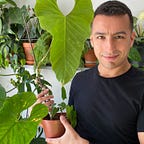Your Orchid doesn’t have to die
Orchids are great houseplants, they love the conditions in most homes, they produce stunning flowers, and they add just that little touch of the exotic to every space.
Unfortunately, orchids have received an unfair reputation as being difficult and tricky to care for as houseplants mostly due to their adaptation to survive in their difficult and inhospitable native environments.
All popular ‘houseplant’ orchids hail from the tropics, and while that might conjure up images of beautiful beaches and cocktails. For plants life in a tropical forest can be a daily struggle for survival.
The most valuable resource for plants in a tropical forest is light. Without light, plants wither away and die. A few thousand years ago orchids came up with an ingenious way to overcome the scarcity of light. They became epiphytic which means that they grow on trees. They do not extract any nutrients from the trees and are thus not parasites. They use the trees as their version of a high-rise apartment building, they simply live on them, and this allows them to soak up the life-giving rays far from the fight on the forest floor. Depending on where in world they are they will share their tree top penthouses with other species who all had similar ideas, bromeliads, hoyas, ferns, and even cacti such as epiphyllum.
Now securing a spot in one of the branches is not easy and even the toughest New York City Co-up board will seem like a cakewalk compared to it. To understand why we need to consider how orchids reproduce.
Each orchid seed pod contains millions and millions of fine dust-like seeds. When the pod is ripe it bursts open and disperses the seeds, that are carried on the air current across the forest to new areas where they may be able to set up home. The seeds are so small that they can be carried across oceans during hurricanes to new habitats. This is how researchers believe certain species of orchids reached Florida from Mexico.
A tiny fraction reaches a suitable habitat, of those a smaller number manage to make it to the germination phase because orchids depend on a beneficial mycorrhizal fungus for all their nutrient needs during the early stages of their development. So you can see that for a seed to be successful it and the fungus must find themselves in the ideal spot.
Let’s assume the seedling and the fungus are in the exact same place and a happy union is formed and a seedling emerges and grows happily attached to the side of a tree. It will still be seven years before any flowers appear and in those seven years, it might be eaten by a snail, trampled by a foraging monkey, or the tree it is attached to might be felled due to logging. It is for this reason of course that every orchid in flower on a tree in the wild is its own mini-miracle or just really good at Survivor.
This brings us to why orchids have been such a challenge for houseplant enthusiasts. They have adapted so perfectly to their native habitats that their care is so far removed from the majority of supermarket houseplants.
This is especially the case with potting medium and watering. As epiphytes, they crave air movement around their roots. In their natural habitat, their roots will creep into the crevices created by the bark of their host tree. This helps to anchor them in place so come hell or a tropical cyclone they will stay put. It also gives them a larger area to ‘catch’ nutrients in the way of bird droppings.
This is why it is extremely important to choose a very porous well-draining medium. So something like bark chips, pebbles, even wine corks. It will help mimic the air-rich natural habitat of your orchid.
In the wild orchids are exposed to frequent short bursts of rainfall. What this does is it drenches the orchid and then the plant can dry off before the next shower. This is why it is always recommended that you water your orchid in a sink where the water can flow through the pot and growing medium. Then you allow your orchid to dry off a bit before returning it to its proper placement.
Light is also very important when it comes to indoor orchid care. I’ve found that indoor orchids require bright indirect light in order to produce flowers. The ideal spot is in front of a bright window shaded by sheer curtains or slatted blinds. Certain species such as Cymbidiums or Cattleyas may require a few hours of direct morning/late afternoon sun in order to thrive.
I fertilize my orchids twice a month with a general orchid fertilizer and organic fertilizers such as kelp or fish emulsion. When using chemical fertilizers flush out the growing medium every other watering to avoid salt build-up in the pot.
I hope you enjoyed this post :)
Corbin
